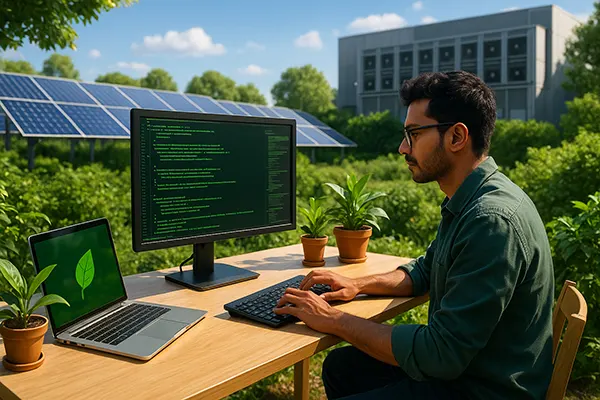Green IT Sector: How Tech Startups Reduce Their Carbon Footprint

In recent years, the environmental impact of digital infrastructure has become a subject of increasing concern. The rapid expansion of cloud services, data centres, and software development has led to an equally rapid increase in energy demand. In response, a growing number of tech startups are actively developing solutions aimed at reducing carbon emissions across the industry. This article explores the real-world initiatives and technologies driving this transformation as of June 2025.
Clean Code and Sustainable Development Practices
One of the core strategies for reducing digital carbon footprints involves optimising code efficiency. Startups now increasingly integrate clean coding principles into their development workflows, enabling applications to consume fewer server resources and less energy. Tools like GreenFrame and EcoCode provide automated assessments of energy usage during coding, helping developers write leaner and more efficient code from the ground up.
Moreover, energy-efficient algorithms play a key role in minimising CPU cycles, particularly for machine learning models. Startups like CodeCarbon offer libraries to estimate and log CO₂ emissions generated by Python scripts, allowing developers to make informed choices during experimentation and deployment.
On a broader scale, agile workflows now often include “green sprints” where development teams focus on improving the sustainability of existing codebases. This fosters a company-wide culture of ecological responsibility within tech startups.
Green Software Engineering Education
The concept of environmentally responsible software design has begun entering university curriculums and corporate onboarding programmes. Institutions in the UK, Germany, and Scandinavia have integrated sustainable computing courses into their tech degree programmes, promoting early awareness among future engineers.
Startups also collaborate with educational platforms like OpenEDG and Coursera to create micro-certification courses on green software development. These initiatives ensure that sustainability becomes a core competence for new developers rather than an afterthought.
Beyond formal education, developer communities such as the Green Software Foundation and ClimateAction.tech host webinars and open-source hackathons, encouraging peer learning and practical engagement with green coding principles.
Data Centre Innovation and Energy Efficiency
Data centres account for a significant portion of global energy consumption, especially in the IT sector. Many startups in 2025 are partnering with green colocation providers and hyper-efficient cloud operators. Services such as Hetzner, Cloud&Heat, and OVHcloud now power their infrastructure using 100% renewable energy, often generated on-site.
Startups also embrace “serverless” architectures, which dynamically allocate computing resources, reducing idle times and unnecessary power consumption. This not only optimises operational costs but significantly cuts down on energy waste.
Liquid cooling technologies have also become a viable option for energy-efficient heat dissipation. Companies like Submer and Asperitas have made strides in producing immersion cooling solutions that are now adopted by AI and high-performance computing startups to reduce cooling overhead.
Carbon-Aware Cloud Operations
A key trend in 2025 is the growth of carbon-aware cloud orchestration. This means dynamically scheduling workloads during periods when clean energy is more available. For example, shifting compute-intensive jobs to off-peak hours when solar or wind power is abundant in the grid.
Microsoft Azure and Google Cloud have both implemented APIs that report carbon intensity in real time, allowing startups to automate greener job scheduling. These APIs inform intelligent pipelines that minimise emissions without compromising performance.
This dynamic orchestration is especially crucial for startups operating globally, as they can target cleaner energy grids in different regions depending on time of day and demand.

Hardware Circularity and Supply Chain Redesign
Startups are increasingly focusing on reducing e-waste by extending the life of their hardware and making better procurement choices. Many have adopted circular economy principles, sourcing refurbished components or engaging in buy-back schemes for outdated devices.
Companies like Back Market and Framework supply high-quality refurbished tech, while initiatives like the Restart Project offer repairable hardware solutions for growing teams. This approach not only reduces environmental impact but also lowers upfront capital expenditure for hardware procurement.
Blockchain is also being used to track material origin and lifecycle, allowing more transparency across the IT hardware supply chain. Startups working in sustainability tech can thus certify the green credentials of their devices and share them with stakeholders.
Zero-Waste Office Initiatives
Remote-first and hybrid startups have a unique advantage in minimising their physical footprint. By reducing office space requirements, they inherently lower energy usage, water consumption, and paper waste. Some firms have transitioned entirely to coworking spaces powered by renewable energy or solar-equipped micro-offices.
Internally, many implement strict procurement guidelines favouring biodegradable or recyclable office materials, and apply strict recycling policies for e-waste. For example, they partner with certified electronics recycling firms to safely dispose of outdated equipment.
Additionally, some startups invest in carbon offsetting programmes for office-related emissions, such as travel, utilities, and logistics. These include projects verified by Gold Standard or Climate Action Reserve.
